My Vegetables: A – Z
All about | Dos & Don’ts | Preparation | Utensils | Cooking Vegetables| Vegetable list
If you don’t know them, you can’t care for them…. or get the best out of them. That’s the philosophy behind this (useful, I hope) guide to vegetables. It will get updated as I find out and test more.
Some general dos and don’ts with Vegetables
- Start out by buying vegetables as fresh as possible
- If you can, buy them when you need them if they perish quickly
- Choose those with good colour and unblemished skin. They should be firm to touch (if they are somewhat hardy), be free of blemishes and pockmarks, have good colour on them. In short, Fresh vegetables should look fresh!
- Don’t rule out frozen if you must – sometimes fresh is not better than frozen. It all depends on the quality and the storage prior to getting to the store.
- Don’t wash them before storage if you plan to refrigerate them – as washing strips off the protective layer, which speeds up the deterioration process.
- Wash them only if you plan to freeze them for later use, otherwise you risk freezing dirt particles, which have adhered to the veggies.
- Store veggies in the cool section of your refrigerator, usually in the trays at the bottom.
- Some people suggest wrapping them in paper to absorb excess moisture. I generally leave my vegetables in the packaging they come in except for my Paprika which comes in a little tray, which I find a bit too long for my fridge. I just take it out and keep it in the vegetable trays of my fridge.
- Note that not all vegetables are meant to be refrigerated (if in whole form) e.g. Tomatoes, Onions, Potatoes, Garlic, Sweet Potatoes, Yams. They can be refrigerated when chopped up/prepared.
- Note that not all vegetables are meant to be washed e.g. Mushrooms.
- Sliced, chopped and prepared vegetables should always be refigerated e.g peeled, raw potatoes should be refigerated.
Wash those vegetables that require it before use.
Leaves and herbs are often sandy…. No one likes gritty salads or greens so take care to wash them well.
I tend to wash my salad leaves by running them under a cold tap and then shaking out the water and drying with some kitchen tissue.
For greens and herbs, I cut off about a centimeter off the ends (of the stalks) and then I fill a bowl/my kitchen sink with cold water. Then in go the leaves and with my hand, I move them around to loosen the dirt. Then I lift them out and into a sieve or colander and let the excess water drain. If you look in the sink, you may be fortunate to see loads of sand and grit…. Which thankfully you’ve avoided eating! I repeat this 2 or 3 times till the leaves are dirt-free and then I give it one last rinse under a running tap and shake off the water. They’re now ready to be prepared.
When preparing veggies, use clean utensils – chopping boards, knives etc. Work with a sharp knife – blunt knifes pose a greater risk to most people than sharp ones .
Some utensils I have in my kitchen which help me immensely include:
Garlic press – I use this to mince both garlic and ginger
Onion chopper – Very useful for chopping onions, carrots, peppers, ginger, garlic and even tomatoes.
Vegetable peeler – Fantastic for peeling vegetables but also for creating ‘garnishes’ like ribbons
Steaming basket – Great for steaming vegetables, works in a variety of pot/pan sizes and comes with a lift-out attachment.
Most vegetables taste better and retain more nutritional elements when steamed than boiled. Stir-frying is also a great way to preserve the natural colours of the vegetables and retain its nutritional value as cooking is quick. Most times it is the prolonged heat during cooking that impairs the nutritional values of food. Sometimes, when I have no space on my stove-top, I resort to using the microwave….
Everyone needs a steamer/steaming basket for successful veggie cooking. These days shops like Ikea stock them quite cheaply, as do other home shops. The advantages of the steaming basket are that they fit into a variety of pots and pans, have legs to stand upon and fold away easily. Get one if you can.
Vegetables are generally cooked and ready when the tip of a sharp knife goes through them with ease. If you want your veggies crunchy, then check after a few minutes. Colour may also be an indication of ‘perfectly cooked’ vegetables. For example when stir-frying broccoli, It is close to being perfect for me (and I mean with a bit of crunch) when it is a vibrant green and hasn’t started ‘smelling’.
Smells/odours are another indication of whether or not vegetables are cooked. Most people hate the smell of Broccoli, Cauliflower, Cabbage and other cruciferous vegetable when they’ve been overcooked because at this point, they’ve released hydrogen sulphide (the trigger of the ‘rotten egg smell’). Of course this affects flavour, smells horrible and results in flatulence.
Tinned vegetables require no cooking though it is a good idea to rinse them so as to get rid of the unnecessary salts and sugars (necessary for canning yes but not for ingestion).
Frozen vegetables don’t require defrosting/thawing. Cook them from frozen. I always have couple of bags of frozen veggies in my deep freezer – a bag of frozen peas and a bag of Mexican mixed veggies – peas, carrots, corn, and chopped paprika. When I eat peas, I tend to use them in great quantity, more than I can shell….. not that I see peas in pods very often to be honest!
Here is a list of vegetables, some peculiar facts about them and notes on the best way to cook them, according to me….
Asparagus
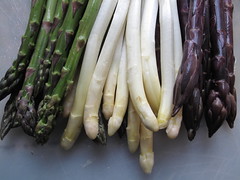 Best refigerated and stored in a tightly wrapped plastic bag or leave in packaging it came in. Asparagus is a big hit in the Netherlands where I live – especially white asparagus. It comes in green, white and purple these days. In the Netherlands, white asparagus is at its best in the spring months from the start of May up to June 21st. It is steamed and served simply with hard-boiled eggs, York ham, potatoes and Hollandaise sauce. The stringy exterior of the asparagus should be stripped with a vegetable peeler and then steamed upright for 10 minutes or until tender. These days you can find special Asparugus steamers – long sieves/colander in pots. Purple asparagus are full -fflavoured and are grown in parts of Italy and in the Loire, Charentes and Aquitaine regions of France. I have cooked white asparagus many times and recently I made a tri-coloured asparagus pie (white, green and purple).
Best refigerated and stored in a tightly wrapped plastic bag or leave in packaging it came in. Asparagus is a big hit in the Netherlands where I live – especially white asparagus. It comes in green, white and purple these days. In the Netherlands, white asparagus is at its best in the spring months from the start of May up to June 21st. It is steamed and served simply with hard-boiled eggs, York ham, potatoes and Hollandaise sauce. The stringy exterior of the asparagus should be stripped with a vegetable peeler and then steamed upright for 10 minutes or until tender. These days you can find special Asparugus steamers – long sieves/colander in pots. Purple asparagus are full -fflavoured and are grown in parts of Italy and in the Loire, Charentes and Aquitaine regions of France. I have cooked white asparagus many times and recently I made a tri-coloured asparagus pie (white, green and purple).
Aubergines
 Best stored at room temperature. Taste delicious fried and in Ratatouilles. Most recipes recommend slicing and salting them prior to cooking, then letting the salt pull out the vegetable’s juices and bitterness. After this, you can go ahead to cook it. I love it sliced into rounds and grilled with a sprinkling of salt and courgettes. Not recommended for freezing from fresh. You cann freeze it cooked in sauces.
Best stored at room temperature. Taste delicious fried and in Ratatouilles. Most recipes recommend slicing and salting them prior to cooking, then letting the salt pull out the vegetable’s juices and bitterness. After this, you can go ahead to cook it. I love it sliced into rounds and grilled with a sprinkling of salt and courgettes. Not recommended for freezing from fresh. You cann freeze it cooked in sauces.
Broccoli
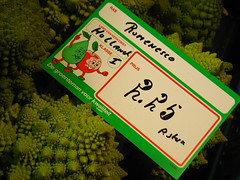 Best refigerated and stored in a tightly wrapped plastic bag or leave in packaging it came in. A (bright) green bouquet of florets attached to a stem. They resemble mini trees. Romanesco broccoli or broccoflower is a cross between Broccoli and Cauliflower. When I cook with Broccoli, I cut them into little florets and steam on low heat till tender to avoid the unpleasant odour and flatulence, which result from over cooking. If using in a stir-fry, I cook them for about 3-4 minutes. This way, the colour is retained.
Best refigerated and stored in a tightly wrapped plastic bag or leave in packaging it came in. A (bright) green bouquet of florets attached to a stem. They resemble mini trees. Romanesco broccoli or broccoflower is a cross between Broccoli and Cauliflower. When I cook with Broccoli, I cut them into little florets and steam on low heat till tender to avoid the unpleasant odour and flatulence, which result from over cooking. If using in a stir-fry, I cook them for about 3-4 minutes. This way, the colour is retained.
Broccoli florets are also great as crudites with some dips….If you want to freezze, best to cook/blanch before freezing as the texture changes if frozen from fresh.
Cabbage
Best refigerated in a tightly wrapped plastic bag or leave in packaging it came in. Cabbage keeps in the fridge for a week or longer. I love cabbage steamed with green peppers and red onions. It is best cooked on low heat till tender to avoid the unpleasant odour and flatulence, which result from over cooking. Whole cabbage leaves also serve as great wraps for fish/vegetables/chicken etc. When used this way, they are steamed over low heat some minutes. Best cooked before freezing, if necessary.
Carrots
Best refigerated in a tightly wrapped plastic bag or leave in packaging it came in. Carrots are tastiest when young. That’s not to say older/larger varieties aren’t as sweet. Majority of the sweetness of a carrot lies in the core and so when cooked, carrots cut into circles taste sweeter than those cut into batons/matchsticks. There is some debate that carrots are more nutritious cooked than raw…. but I’m not haven’t done any studies to verify them. My daughter and I love them Mexican style – raw carrots cut into batons, topped with juice from a fresh lime and then sprinkled with some piri-piri spice and salt. Delicious but has to be eaten immediately or the carrots go soft from the acid in the lime. Great snack! Best blanched/steamed before freezing.
Cauliflower
Best refigerated in a tightly wrapped plastic bag or leave in packaging it came in. These consist of a head of little florets, which are generally cut up. Cooking directions are the same as for Broccoli. They are fantastic baked with cheese and steamed/stir-fried with tumeric. They are great to serve as fantastic crudites, especially when young and the florets are light and crunchy. Best steamed/cooked before freezing.
Cucumber
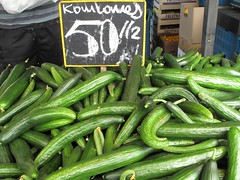 Best refigerated (at its worst when frozen) Keep in a tightly wrapped plastic bag or leave in packaging it came in. Cucumbers are great and refreshing. I love to slice them and put in my salads. My daughter loves them with Ketchup! They are nice cut into batons for crudites. If you want to de-seed them, cut them in half lengthways and using a teaspoon, run it down the core where the seeds are. Discard. Use as needed.
Best refigerated (at its worst when frozen) Keep in a tightly wrapped plastic bag or leave in packaging it came in. Cucumbers are great and refreshing. I love to slice them and put in my salads. My daughter loves them with Ketchup! They are nice cut into batons for crudites. If you want to de-seed them, cut them in half lengthways and using a teaspoon, run it down the core where the seeds are. Discard. Use as needed.
You can also create Cucumber ribbons by slicing a cucumber down lengthways using a vegetable peeler. Some Chinese dishes include cucumbers in stir-fry dishes. I have a recipe for pickled cucumber which I’ll feature in the coming weeks this summer! Watch out Deb.
Fennel
 Best refigerated in a tightly wrapped plastic bag or leave in packaging it came in. I have tried this only once and what a joy. I’d always avoided Fennel because I knew it had an aniseedy taste…. I’m not hot on that particular flavour and so I avoided buying it. I have used fennel seeds in curries and the closest I’d ever gotten to the fresh stuff was some fennel leaves picked around the Eastern Spanish hills of Cuenca which I used in a Fish recipe. It was lovely.
Best refigerated in a tightly wrapped plastic bag or leave in packaging it came in. I have tried this only once and what a joy. I’d always avoided Fennel because I knew it had an aniseedy taste…. I’m not hot on that particular flavour and so I avoided buying it. I have used fennel seeds in curries and the closest I’d ever gotten to the fresh stuff was some fennel leaves picked around the Eastern Spanish hills of Cuenca which I used in a Fish recipe. It was lovely.
But a few days ago, I bought one fennel bulb which we had….. Amazing. Easy to prep. Quick to cook and super delicious. The feared aniseed taste was actually a very, very mild but delicious one which went swimmingly well with some pan-grilled seabass fillets and some Spaghettini!
To prepare Fennel, wash the bulb and then slice off the hard base – about 1/2 a centimetre from the bottom. Using a vegetable peeler, gently remove the hard exterior. Then slice thinly and cook as desired. When I made it, I fried it in some oil and then added it to a sauce for Pasta.
Garlic
Best stored at room temperature. Easiest way to mince/puree garlic is with a garlic press. With the press, you don’t have to peel it, you pop the clove in – skin and all and out comes the cream. If you want to peel it by hand, place a clove on a chopping board and with the lower edge of your palm, hit down on it to crush the base, then peel. You can slice, grate or chop it up as required. You can store minced garlic in the fridge (covered with some oil). It is also easy to freeze and use from frozen. Use within a week or two.
Ginger
Best refigerated, unpeeled. Fresh ginger can keep in the refigerator for many months. It is easy to peel. Use the back of a spoon to scrape the skin off – this avoids waste, is easy to do and results in well-peeled ginger. For use, you can grate it with a small/medium holed grater, press it through a garlic press or slice/chop it up with a knife. It is also easy to store minced ginger in the fridge, covered with some oil. Use within a week or two.
Green beans
 Best refigerated.Easy to prepare – gather as many beans as you can, lining them up. Then slice off top. Do the same for the tail (I do recognise that beans are not always the same length and sometimes you have to move them back and forth to get the ends all lined up. I love them steamed and then tossed in butter. Don’t cook too long or they lose their taste and colour, turning a ‘sour’ green. Not so nice.
Best refigerated.Easy to prepare – gather as many beans as you can, lining them up. Then slice off top. Do the same for the tail (I do recognise that beans are not always the same length and sometimes you have to move them back and forth to get the ends all lined up. I love them steamed and then tossed in butter. Don’t cook too long or they lose their taste and colour, turning a ‘sour’ green. Not so nice.
Green peas
I love green peas. I must confess that I mostly buy them frozen. I haven’t had the time in years to shell out the quantities I typically cook for a meal. I cook mine from frozen by steaming if serving them in a mix or microwaving/boiling in a little water when I want to make a puree.
Lettuce
Best refigerated . Easy to prepare. Wash before using to remove sand. If using leafy varieties, rinse them in water using the same technique for herbs. If you have a salad spinner, use that to dry the keaves otherwise dry with kitchen tissue. When using in a salad, it is preferable to tear the leaves by hand so as to prevent Vitamin C-destroying enzymes from being released. If this is not possible, use a silver or stainless steel knife to chop. This slows down the release of the enzymes. There are some supporters of using rubber knives as well. Some Chinese recipes call for stir-frying, use as directed. Lettuce should not be frozen – the crisp testure is destroyed.
Mushrooms
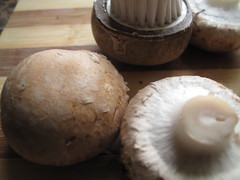 Best refigerated in a plastic bag but leave mushrooms loose so they can breathe or leave in packaging it came in.. Mushrooms are soft and have a lot of pore spaces which are easily filled with water. Because of this porosity, there is wide agreement that they should be cleaned with a ‘mushroom brush’ or wiped with some kitchen tissue and not washed before use.
Best refigerated in a plastic bag but leave mushrooms loose so they can breathe or leave in packaging it came in.. Mushrooms are soft and have a lot of pore spaces which are easily filled with water. Because of this porosity, there is wide agreement that they should be cleaned with a ‘mushroom brush’ or wiped with some kitchen tissue and not washed before use.
Onions
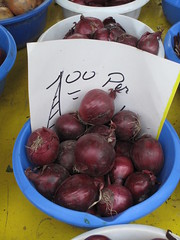 Cooking onions are best kept at room temperature in a dry, dark and open place. Spring /green onions however should be refrigerated . Most people find it easier to slice onions, which have been kept under a running tap or refigerated for a while before chopping/slicing. If you are averse to chopping onions, get an onion chopper.
Cooking onions are best kept at room temperature in a dry, dark and open place. Spring /green onions however should be refrigerated . Most people find it easier to slice onions, which have been kept under a running tap or refigerated for a while before chopping/slicing. If you are averse to chopping onions, get an onion chopper.
My Mexican friend, yes the same one from the carrots taught me this quick pickle with lime juice. First of all, slice some onions… red or white. In this case , I sliced half and onion and put it in a bowl and then squeezed the juice from 3 limes and then salted it. Every now and again, I gave it a stir with a spoon while leaving it to marinade for about an hour. When it was ready, I used… over a delicious homemade hamburger. Great and fresh.
Paprika/Bell peppers
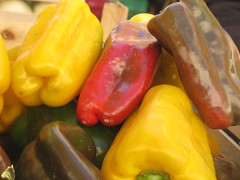 Best refigerated in a bag. To use Paprikas, they should always be de-seeded and the veins should be removed (as for chilies if you don’t want them hot.). To keep them crisp, eat raw, steam chopped bits for a few minutes or stir-fry. They are equally delicious grilled till blackened and then skinned. They make a lovely, colourful and tasty addition to salads, pasta and even sandwiches.
Best refigerated in a bag. To use Paprikas, they should always be de-seeded and the veins should be removed (as for chilies if you don’t want them hot.). To keep them crisp, eat raw, steam chopped bits for a few minutes or stir-fry. They are equally delicious grilled till blackened and then skinned. They make a lovely, colourful and tasty addition to salads, pasta and even sandwiches.
If you want to stuff a paprika, slice it in half lengthways, remove the vein and seeds and then fill and cook as desired.
If you want to stuff or cook smaller sweet peppers, slice off the stalk and then with a knife or spoon, scrape out the seeds, then use as desired.
Plantains
 Best stored at room temperature. Treat just as you would bananas. They further ripen with time. When ripe, you can refigerate. This affects the texture but not necessarily the taste. As they ripen from green, the starches transform into sugars so that yellow plantains are a lot sweeter than green ones.
Best stored at room temperature. Treat just as you would bananas. They further ripen with time. When ripe, you can refigerate. This affects the texture but not necessarily the taste. As they ripen from green, the starches transform into sugars so that yellow plantains are a lot sweeter than green ones.
Potatoes
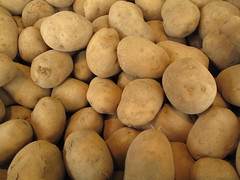 Best kept at room temperature in a dry, open place where they can breathe. Potatoes and sweet potatoes are tastiest when cooked in their jackets. To do this, thoroughly scrub the skin and rinse then bring to boil in a pan (with water to cover the potatoes). When they have come to the boil, reduce the heat and simmer for 20 minutes or unit a knife goes through to the core with ease. Then drain off and leave pot open to let steam escape. You can then peel and use as desired in salads or as part of a meal.
Best kept at room temperature in a dry, open place where they can breathe. Potatoes and sweet potatoes are tastiest when cooked in their jackets. To do this, thoroughly scrub the skin and rinse then bring to boil in a pan (with water to cover the potatoes). When they have come to the boil, reduce the heat and simmer for 20 minutes or unit a knife goes through to the core with ease. Then drain off and leave pot open to let steam escape. You can then peel and use as desired in salads or as part of a meal.
Left-over boiled potatoes can be fried or used in other ways.
Pumpkin
 Whole pumpkin should be stored at room temperatureest refigerated. They are best refigerated if cut or purchased in halves/segments. I love pumpkin, sliced thin and slowly pan fried or cut into chunks, oven-roasted and pureed to make a soup….
Whole pumpkin should be stored at room temperatureest refigerated. They are best refigerated if cut or purchased in halves/segments. I love pumpkin, sliced thin and slowly pan fried or cut into chunks, oven-roasted and pureed to make a soup….
Pumpkin flowers are also lovely to eat – fried, stuffed or cooked in pasta like I had and made in Rome. The flowers can be refigerated for a few days. I just trim the about 1cm off the ends, slice them – stalks and petals and stir-fry for a few minutes so the stalks retain some of their crunch even when the leaves are soft.
Spinach
Best refigerated in packaging it came in or wrapped up tightly in a bag. Treat as other leaves/herbs. I generally find it easier to cook it from frozen cause I don’t have to chop it up then. I freeze a bag of washed spinach and then when I want to use it, bring it out and while frozen, use my hands to crush the leaves, then cook as needed. Great wilted in a pan with butter and garlic.
Tomatoes
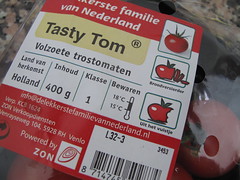 Best stored at room temperature. Refrigeration alters the taste and texture of this red vegetable. They can be used whole or de-skinned and deseeded. Best sliced with a sharp knife. My favourite knife for this is my serrated little knife. Tomatoes are more nutritious cooked because the lycopene is transformed into a more absorbable types for the bodies.
Best stored at room temperature. Refrigeration alters the taste and texture of this red vegetable. They can be used whole or de-skinned and deseeded. Best sliced with a sharp knife. My favourite knife for this is my serrated little knife. Tomatoes are more nutritious cooked because the lycopene is transformed into a more absorbable types for the bodies.
Yams
Yams should be stored at room temperature. Generally not frozen in their raw state. If you must freeze them, then wash, prepare and freeze as you will but cook from frozen.
This site uses Akismet to reduce spam. Learn how your comment data is processed.


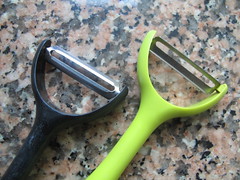

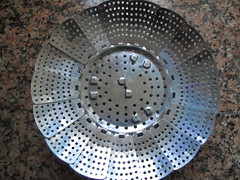
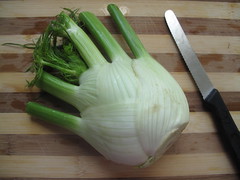
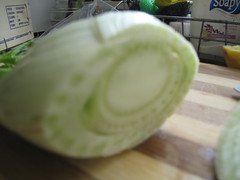
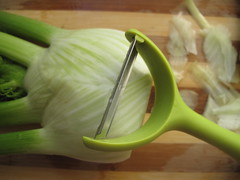
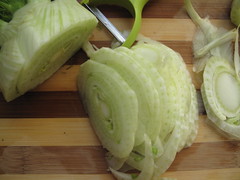
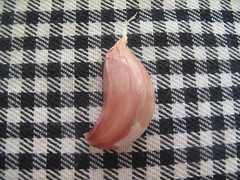
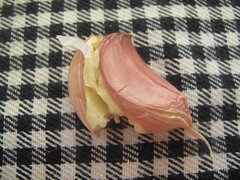

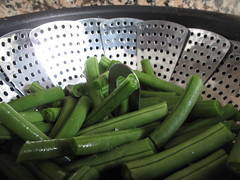
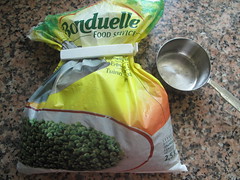
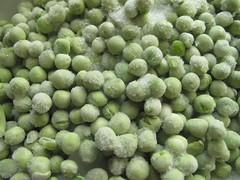





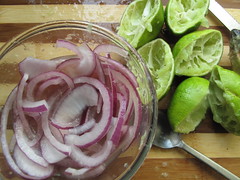

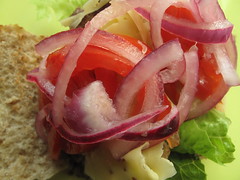


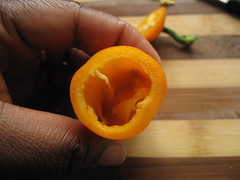

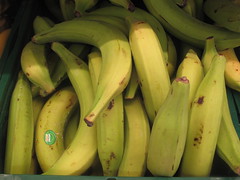
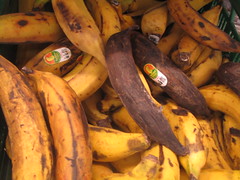
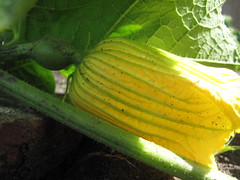
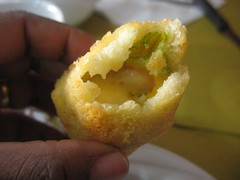
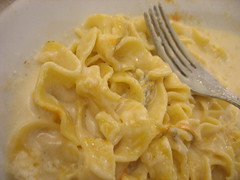


Leave a Reply